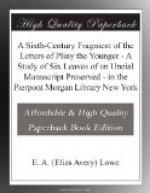Tastes differ, and not all these eleven readings of Class I may be errors. Kukula, in the most recent Teubner edition (1912), accepts three of them (60, 15; 62, 6; 65, 15), and Merrill, in his forthcoming edition, five (60, 15; 61, 12; 62, 6; 65, 12; 65, 15). Personally I could be reconciled to them all with the exception of the very two which Aldus could not admit—62, 23 and 64, 3; in both places he had the early editions to fall back on. However, I should concur with Merrill and Kukula in preferring the reading of the other classes in 62, 16 and 65, 24. In 65, 11 I would emend to alii quidam minoris sed tamen numeri; if this is the right reading, _{Pi}BF_ agree in the easy error of quidem for quidam, and MVD in another easy error, minores for minoris—the parent manuscript of MV further changed tamen numeri to tam innumeri. Whatever the final judgment, here are five cases in which all recent editors would attribute error to Class I; in the remaining six cases the manuscripts of Class I either agree in error or avoid the error of Class II—surely, then, _{Pi}_ is not of the latter class. There are six other significant errors of MV in the whole passage, no one of which appears in _{Pi}_: 61, 15 si non] sint MV; 62, 6 mira illis] mirabilis MV; 62, 11 lotus] illic MV; cibum] cibos MV; 62, 25 fuit—64, 12 potes] om. MV; 66, 12 amatus] est amatus MV. Once the first hand in _{Pi}_ agrees with V in an error easily committed independently: 61, 12 ordinata] ORDINATA, DI ss. m. 2 _{Pi}_ ornata V.
_{Pi}_, then, and MV have descended from the archetype by different routes. With Class III, the Verona branch of Class II, _{Pi}_ clearly has no close association.
But the evidence for allying _{Pi}_ with B and F, the manuscripts of Class I, is by no means exhausted. In 61, 14, BFux have the erroneous emendation, which Budaeus includes among his variants, of serua for sera. A glance at _{Pi}_ shows its apparent origin. The first hand has SERA correctly; the second hand writes U above the line.[32] If the second hand is solely responsible for the attempt at improvement here, and is not reproducing a variant in the parent manuscript of _{Pi}_, then BF must descend directly from _{Pi}_. The following instances point in the same direction: 61, 21 considit] considet BF. _{Pi}_ has CONSIDIT by the first hand, the second hand changing the second I to a capital E.[33] In 65, 5, however, RESIDIT is not thus changed in _{Pi}_, and perhaps for this very reason is retained by the careful scribe of B; F, which has a slight tendency to emend, has, with G, residet. 63, 9 praestat amat me] praestatam ad me B. Here the letters of the scriptura continua in _{Pi}_ are faded and blurred; the error of B




